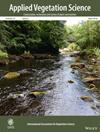Hydrologic Restoration of Retired Cranberry Farms Leads to Species Rich Wetlands
Abstract
Questions
Formerly cultivated lands are common targets for wetland restoration, but human interventions needed to achieve diverse plant communities in sites with agricultural legacies are not well understood. We studied pre-restoration seed banks and pre- and post-restoration plant communities of former cranberry farms, whose native peat was covered with anthropogenically placed sand during cultivation and that underwent hydrologic restoration.
Location
Three retired cranberry (Vaccinium macrocarpon Aiton) farm complexes in southeast Massachusetts, USA, that underwent hydrologic restoration between 2017 and 2020.
Methods
We quantified seed germination from sand and peat collected from former farms in a greenhouse under three hydrologic treatments (inundated, saturated, and well-drained) to assess the pre-restoration seed bank composition. In the field, we surveyed plant species presence and cover both before and after restoration at permanent 9 m2 plots. We assessed species composition, richness, and diversity in seed bank treatments and in situ. We also measured changes in in situ vegetation over time and compared seed bank and in situ vegetation.
Results
The 30 species that germinated from retired cranberry farm seed banks were primarily native, perennial, wetland-adapted, and occurred in the sand but not peat. Highest germination rates and species richness occurred in saturated substrate, with very little germination in the well-drained treatment. Seed banks were not predictive of post-restoration in situ species richness, but post-restoration vegetation was similarly native, perennial, and wetland-adapted. Restoration increased in situ total plant and wetland-adapted plant species richness compared with pre-restoration, and this richness persisted for multiple years post-restoration. Wetland plant cover was more variable and likely affected by year-to-year changes in growing season precipitation.
Conclusions
Vegetation responses to wetland restoration at formerly cultivated sites indicate that diverse, native plant communities can regenerate following hydrologic restoration in sites with sandy, nutrient-poor soils.


 求助内容:
求助内容: 应助结果提醒方式:
应助结果提醒方式:


